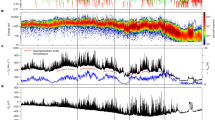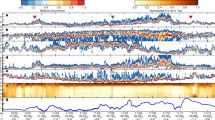Abstract
Many rotating stars have magnetic fields that interact with the winds they produce. The Sun is no exception. The interaction between the Sun’s magnetic field and the solar wind gives rise to the heliospheric magnetic field—a spiralling magnetic structure, known as the Parker spiral, which pervades the Solar System. This magnetic field is critical for governing plasma processes that source the solar wind. Here, we report the creation of a laboratory model of the Parker spiral system based on a rapidly rotating plasma magnetosphere and the measurement of its global structure and dynamic behaviour. This laboratory system exhibits regions where the plasma flows evolve in a similar manner to many magnetized stellar winds. We observe the advection of the magnetic field into an Archimedean spiral and the ejection of quasi-periodic plasma blobs into the stellar outflow, which mimics the observed plasmoids that fuel the slow solar wind. This process involves magnetic reconnection and can be modelled numerically by the inclusion of two-fluid effects in the simulation. The Parker spiral system mimicked in the laboratory can be used for studying solar wind dynamics in a complementary fashion to conventional space missions such as NASA’s Parker Solar Probe mission.
This is a preview of subscription content, access via your institution
Access options
Access Nature and 54 other Nature Portfolio journals
Get Nature+, our best-value online-access subscription
$29.99 / 30 days
cancel any time
Subscribe to this journal
Receive 12 print issues and online access
$209.00 per year
only $17.42 per issue
Buy this article
- Purchase on Springer Link
- Instant access to full article PDF
Prices may be subject to local taxes which are calculated during checkout





Similar content being viewed by others
Data availability
Raw data were generated at the Big Red Ball facility at the Wisconsin Plasma Physics Laboratory. Derived data supporting the findings of this study are available from the corresponding author upon reasonable request.
Code availability
Information about the NIMROD code, including publications and licensing policies, is available at https://nimrodteam.org. Code produced for analysing data at the Big Red Ball Facility is available from the corresponding author upon reasonable request.
References
Parker, E. N. Dynamics of the interplanetary gas and magnetic fields. Astrophys. J. 128, 664–676 (1958).
Gringauz, K. I., Bezrokikh, V. V., Ozerov, V. D. & Rybchinskii, R. E. A study of the interplanetary ionized gas, high-energy electrons and corpuscular radiation from the Sun by means of the three-electrode trap for charged particles on the second Soviet cosmic rocket. Sov. Phys. Dokl. 5, 361–364 (1960).
Neugebauer, M. & Snyder, C. W. Solar plasma experiment. Science 138, 1095–1097 (1962).
Somov, B. V. & Syrovatskii, S. I. Appearance of a current (neutral) sheet in a plasma moving in the field of a two-dimensional magnetic dipole. J. Exp. Theor. Phys. 34, 992–997 (1972).
Einaudi, G., Chibbaro, S., Dahlburg, R. B. & Velli, M. Plasmoid formation and acceleration in the solar streamer belt. Astrophys. J. 547, 1167–1177 (2001).
Fox, N. J. et al. The solar probe plus mission: humanity’s first visit to our star. Space Sci. Rev. 204, 7–48 (2016).
Szabo, A. Flying into the sun. Nat. Astron. 2, 829–829 (2018).
Brooks, D. H., Ugarte-Urra, I. & Warren, H. P. Full-sun observations for identifying the source of the slow solar wind. Nat. Commun. 6, 5947 (2015).
Crooker, N. U. et al. Multiple heliospheric current sheets and coronal streamer belt dynamics. J. Geophys. Res. 98, 9371–9381 (1993).
Einaudi, G., Boncinelli, P., Dahlburg, R. B. & Karpen, J. T. Formation of the slow solar wind in a coronal streamer. J. Geophys. Res. Space Phys. 104, 521–534 (1999).
Parker, E. Dynamical theory of the solar wind. Space Sci. Rev. 4, 666–708 (1965).
Mullan, D. J. & Smith, C. W. Solar wind statistics at 1 au: Alfven speed and plasma beta. Sol. Phys. 234, 325–338 (2006).
Balogh, A. et al. The heliospheric magnetic field over the south polar region of the Sun. Science 268, 1007–1010 (1995).
DeForest, C. E., Howard, R. A., Velli, M., Viall, N. & Vourlidas, A. The highly structured outer solar corona. Astrophys. J. 862, 18 (2018).
Cranmer, S. R., Gibson, S. E. & Riley, P. Origins of the ambient solar wind: implications for space weather. Space Sci. Rev. 212, 1345–1384 (2017).
Goldstein, B. E. et al. Ulysses plasma parameters: latitudinal, radial and temporal variations. Astron. Astrophys. 316, 296–303 (1996).
Antiochos, S. K., Mikić, Z., Titov, V. S., Lionello, R. & Linker, J. A. A model for the sources of the slow solar wind. Astrophys. J. 731, 112 (2011).
Sheeley, N. R. Jr. et al. Measurements of flow speeds in the corona between 2 and 30R ⊙. Astrophys. J. 484, 472–478 (1997).
Wang, Y.-M. et al. Origin of streamer material in the outer corona. Astrophys. J. 498, L165–L168 (1998).
Higginson, A. K. & Lynch, B. J. Structured slow solar wind variability: streamer-blob flux ropes and torsional Alfvén waves. Astrophys. J. 859, 6 (2018).
Sovinec, C. & King, J. Analysis of a mixed semi-implicit/implicit algorithm for low-frequency two-fluid plasma modeling. J. Comput. Phys. 229, 5803–5819 (2010).
Forest, C. B. et al. The Wisconsin plasma astrophysics laboratory. J. Plasma Phys. 81, 345810501 (2015).
Levitt, B., Maslovsky, D. & Mauel, M. E. Observation of centrifugally driven interchange instabilities in a plasma confined by a magnetic dipole. Phys. Rev. Lett. 94, 175002 (2005).
Birkeland, K. De l’origine des mondes. Arch. Sci. Phys. Nat. T. 35, 529–564 (1913).
Collins, C. et al. Stirring unmagnetized plasma. Phys. Rev. Lett. 108, 115001 (2012).
Weisberg, D. B. et al. Driving large magnetic Reynolds number flow in highly ionized, unmagnetized plasmas. Phys. Plasmas 24, 056502 (2017).
Köhnlein, W. Radial dependence of solar wind parameters in the ecliptic (1.1R ⊙−61 au). Sol. Phys. 169, 209–213 (1996).
Zhu, P. & Raeder, J. Plasmoid formation in current sheet with finite normal magnetic component. Phys. Rev. Lett. 110, 235005 (2013).
Kivelson, M. G. & Southwood, D. J. Dynamical consequences of two modes of centrifugal instability in Jupiter’s outer magnetosphere. J. Geophys. Res. Space Phys. 110, A12209 (2005).
Shibasaki, K. High-beta disruption in the solar atmosphere. Astrophys. J. 557, 326–331 (2001).
Hood, A. W. Ballooning instabilities in the solar corona: conditions for stability. Sol. Phys. 103, 329–345 (1986).
Burch, J. L., Moore, T. E., Torbert, R. B. & Giles, B. L. Magnetospheric multiscale overview and science objectives. Space Sci. Rev. 199, 5–21 (2016).
Endeve, E., Holzer, T. E. & Leer, E. Helmet streamers gone unstable: two-fluid magnetohydrodynamic models of the solar corona. Astrophys. J. 603, 307–321 (2004).
Acknowledgements
The present work was supported by the NASA Earth and Space Sciences–Heliophysics Division Fellowship. The facility was constructed with support from the National Science Foundation and is now operated as a Department of Energy National User Facility.
Author information
Authors and Affiliations
Contributions
E.E.P. designed and built the linear Hall probe array, mach and triple probes, executed the experiments and data acquisition, performed all the data analysis and NIMROD simulations and wrote the majority of the text. D.A.E. constructed the magnet, electrode system and capacitor bank trigger circuit and was a partner in running the experiments. D.A.E., M.C., R.W. and E.E.P. constructed the capacitor banks. J.W. designed and constructed motorized probe stages and maintained the vacuum system. C.R.S., K.J.B. and M.B. were instrumental in making modifications to the NIMROD code to be applicable to this experiment and aided in interpreting the simulation results. K.F. and K.J.M. contributed to the compiling of NIMROD. J.M., K.F., J.O. and D.A.E. contributed to construction of the control software and interpreting the data. C.B.F. and J.E. contributed to the interpretation of data and simulations as well as to the writing and editing of the manuscript. C.B.F. is the principal investigator and director of WiPPL, and provided the overall leadership for this project.
Corresponding author
Ethics declarations
Competing interests
The authors declare no competing interests.
Additional information
Peer review information: Nature Physics thanks R. Paul Drake, Nicola Fox and Kristopher Klein for their contribution to the peer review of this work.
Publisher’s note: Springer Nature remains neutral with regard to jurisdictional claims in published maps and institutional affiliations.
Supplementary information
Supplementary Information
Supplementary Information on the Supplementary Videos.
Supplementary Video 1
Visible light emission captures both broadband and coherent fluctuations.
Supplementary Video 2
Experimental measurements reveal reconnection and plasmoid ejection.
Supplementary Video 3
Hall-MHD simulation reveals plasmoids with similar frequency to the experiment.
Rights and permissions
About this article
Cite this article
Peterson, E.E., Endrizzi, D.A., Beidler, M. et al. A laboratory model for the Parker spiral and magnetized stellar winds. Nat. Phys. 15, 1095–1100 (2019). https://doi.org/10.1038/s41567-019-0592-7
Received:
Accepted:
Published:
Issue Date:
DOI: https://doi.org/10.1038/s41567-019-0592-7
This article is cited by
-
15 years of Nature Physics
Nature Physics (2020)



